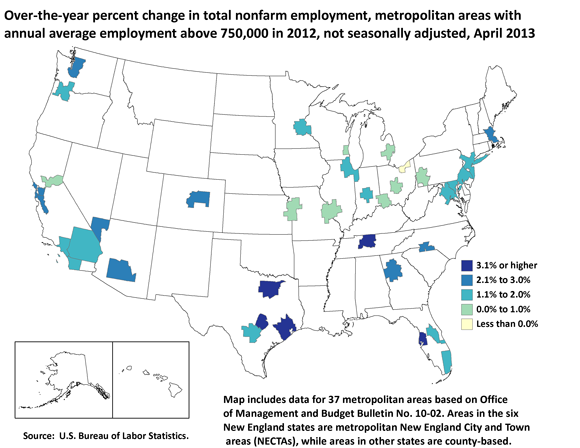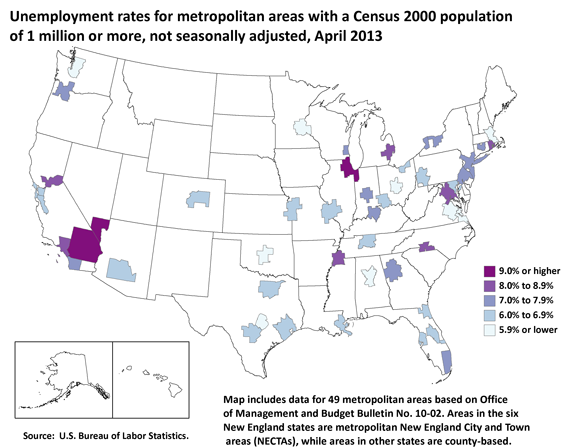An official website of the United States government
 United States Department of Labor
United States Department of Labor
From April 2012 to April 2013, nonfarm employment rose in 36 of the 37 metropolitan areas with annual average employment levels above 750,000 in 2012. Among the 49 metropolitan areas with a Census 2000 population of 1 million or more, 42 reported over-the-year unemployment rate decreases, 4 registered increases, and 3 had no change.

| Area | Percent change (p) |
|---|---|
Houston-Sugar Land-Baytown, TX Metropolitan Statistical Area | 4.2 |
Nashville-Davidson--Murfreesboro--Franklin, TN Metropolitan Statistical Area | 3.9 |
Austin-Round Rock-San Marcos, TX Metropolitan Statistical Area | 3.8 |
Dallas-Fort Worth-Arlington, TX Metropolitan Statistical Area | 3.5 |
Tampa-St. Petersburg-Clearwater, FL Metropolitan Statistical Area | 3.1 |
San Jose-Sunnyvale-Santa Clara, CA Metropolitan Statistical Area | 2.7 |
Denver-Aurora-Broomfield, CO Metropolitan Statistical Area | 2.7 |
Charlotte-Gastonia-Rock Hill, NC-SC Metropolitan Statistical Area | 2.5 |
Phoenix-Mesa-Glendale, AZ Metropolitan Statistical Area | 2.4 |
Las Vegas-Paradise, NV Metropolitan Statistical Area | 2.4 |
San Francisco-Oakland-Fremont, CA Metropolitan Statistical Area | 2.2 |
Seattle-Tacoma-Bellevue, WA Metropolitan Statistical Area | 2.2 |
Atlanta-Sandy Springs-Marietta, GA Metropolitan Statistical Area | 2.1 |
Los Angeles-Long Beach-Santa Ana, CA Metropolitan Statistical Area | 2.0 |
San Diego-Carlsbad-San Marcos, CA Metropolitan Statistical Area | 2.0 |
Baltimore-Towson, MD Metropolitan Statistical Area | 2.0 |
Indianapolis-Carmel, IN Metropolitan Statistical Area | 1.9 |
Boston-Cambridge-Quincy, MA-NH Metropolitan NECTA | 1.9 |
New York-Northern New Jersey-Long Island, NY-NJ-PA Metropolitan Statistical Area | 1.9 |
Riverside-San Bernardino-Ontario, CA Metropolitan Statistical Area | 1.6 |
San Antonio-New Braunfels, TX Metropolitan Statistical Area | 1.6 |
Orlando-Kissimmee-Sanford, FL Metropolitan Statistical Area | 1.5 |
Minneapolis-St. Paul-Bloomington, MN-WI Metropolitan Statistical Area | 1.5 |
Washington-Arlington-Alexandria, DC-VA-MD-WV Metropolitan Statistical Area | 1.4 |
Portland-Vancouver-Hillsboro, OR-WA Metropolitan Statistical Area | 1.3 |
Philadelphia-Camden-Wilmington, PA-NJ-DE-MD Metropolitan Statistical Area | 1.2 |
Miami-Fort Lauderdale-Pompano Beach, FL Metropolitan Statistical Area | 1.1 |
Chicago-Joliet-Naperville, IL-IN-WI Metropolitan Statistical Area | 1.1 |
Sacramento--Arden-Arcade--Roseville, CA Metropolitan Statistical Area | 1.0 |
Cincinnati-Middletown, OH-KY-IN Metropolitan Statistical Area | 0.9 |
Pittsburgh, PA Metropolitan Statistical Area | 0.9 |
St. Louis, MO-IL Metropolitan Statistical Area | 0.8 |
Kansas City, MO-KS Metropolitan Statistical Area | 0.7 |
Columbus, OH Metropolitan Statistical Area | 0.7 |
Detroit-Warren-Livonia, MI Metropolitan Statistical Area | 0.6 |
Milwaukee-Waukesha-West Allis, WI Metropolitan Statistical Area | 0.2 |
Cleveland-Elyria-Mentor, OH Metropolitan Statistical Area | -0.4 |
Footnotes: | |
In April 2013, the largest over-the-year percentage increase in employment in large metropolitan areas occurred in Houston-Sugar Land-Baytown, Texas (+4.2 percent), followed by Nashville-Davidson—Murfreesboro—Franklin, Tennessee (+3.9 percent), and Austin-Round Rock-San Marcos, Texas (+3.8 percent). The only large area that had an over-the-year percentage decrease in employment was Cleveland-Elyria-Mentor, Ohio (−0.4 percent).
Among large areas, Las Vegas-Paradise, Nevada, and Riverside-San Bernardino-Ontario, California, had the highest unemployment rates in April, 9.6 percent each. Oklahoma City, Oklahoma, had the lowest jobless rate among the large areas, 4.1 percent.

| Area | Unemployment rate (p) |
|---|---|
Riverside-San Bernardino-Ontario, CA Metropolitan Statistical Area | 9.6 |
Las Vegas-Paradise, NV Metropolitan Statistical Area | 9.6 |
Chicago-Joliet-Naperville, IL-IN-WI Metropolitan Statistical Area | 9.1 |
Providence-Fall River-Warwick, RI-MA Metropolitan NECTA | 9.0 |
Memphis, TN-MS-AR Metropolitan Statistical Area | 9.0 |
Detroit-Warren-Livonia, MI Metropolitan Statistical Area | 8.9 |
Los Angeles-Long Beach-Santa Ana, CA Metropolitan Statistical Area | 8.4 |
Charlotte-Gastonia-Rock Hill, NC-SC Metropolitan Statistical Area | 8.4 |
Sacramento--Arden-Arcade--Roseville, CA Metropolitan Statistical Area | 8.3 |
Hartford-West Hartford-East Hartford, CT Metropolitan NECTA | 7.8 |
Buffalo-Niagara Falls, NY Metropolitan Statistical Area | 7.7 |
Philadelphia-Camden-Wilmington, PA-NJ-DE-MD Metropolitan Statistical Area | 7.7 |
Atlanta-Sandy Springs-Marietta, GA Metropolitan Statistical Area | 7.6 |
New York-Northern New Jersey-Long Island, NY-NJ-PA Metropolitan Statistical Area | 7.5 |
Milwaukee-Waukesha-West Allis, WI Metropolitan Statistical Area | 7.5 |
Indianapolis-Carmel, IN Metropolitan Statistical Area | 7.4 |
Louisville-Jefferson County, KY-IN Metropolitan Statistical Area | 7.4 |
Miami-Fort Lauderdale-Pompano Beach, FL Metropolitan Statistical Area | 7.2 |
Rochester, NY Metropolitan Statistical Area | 7.2 |
Portland-Vancouver-Hillsboro, OR-WA Metropolitan Statistical Area | 7.1 |
San Diego-Carlsbad-San Marcos, CA Metropolitan Statistical Area | 7.0 |
Denver-Aurora-Broomfield, CO Metropolitan Statistical Area | 6.7 |
Tampa-St. Petersburg-Clearwater, FL Metropolitan Statistical Area | 6.7 |
Baltimore-Towson, MD Metropolitan Statistical Area | 6.7 |
St. Louis, MO-IL Metropolitan Statistical Area | 6.7 |
Phoenix-Mesa-Glendale, AZ Metropolitan Statistical Area | 6.6 |
San Jose-Sunnyvale-Santa Clara, CA Metropolitan Statistical Area | 6.6 |
Cleveland-Elyria-Mentor, OH Metropolitan Statistical Area | 6.6 |
Cincinnati-Middletown, OH-KY-IN Metropolitan Statistical Area | 6.5 |
Orlando-Kissimmee-Sanford, FL Metropolitan Statistical Area | 6.4 |
Pittsburgh, PA Metropolitan Statistical Area | 6.4 |
Nashville-Davidson--Murfreesboro--Franklin, TN Metropolitan Statistical Area | 6.4 |
Jacksonville, FL Metropolitan Statistical Area | 6.3 |
San Francisco-Oakland-Fremont, CA Metropolitan Statistical Area | 6.2 |
New Orleans-Metairie-Kenner, LA Metropolitan Statistical Area | 6.2 |
Kansas City, MO-KS Metropolitan Statistical Area | 6.1 |
Dallas-Fort Worth-Arlington, TX Metropolitan Statistical Area | 6.0 |
Houston-Sugar Land-Baytown, TX Metropolitan Statistical Area | 5.9 |
San Antonio-New Braunfels, TX Metropolitan Statistical Area | 5.9 |
Boston-Cambridge-Quincy, MA-NH Metropolitan NECTA | 5.7 |
Columbus, OH Metropolitan Statistical Area | 5.7 |
Richmond, VA Metropolitan Statistical Area | 5.4 |
Virginia Beach-Norfolk-Newport News, VA-NC Metropolitan Statistical Area | 5.4 |
Birmingham-Hoover, AL Metropolitan Statistical Area | 5.2 |
Seattle-Tacoma-Bellevue, WA Metropolitan Statistical Area | 5.2 |
Austin-Round Rock-San Marcos, TX Metropolitan Statistical Area | 5.1 |
Washington-Arlington-Alexandria, DC-VA-MD-WV Metropolitan Statistical Area | 5.0 |
Minneapolis-St. Paul-Bloomington, MN-WI Metropolitan Statistical Area | 4.9 |
Oklahoma City, OK Metropolitan Statistical Area | 4.1 |
Footnotes: | |
From April 2012 to April 2013, the largest unemployment rate declines occurred in Riverside-San Bernardino-Ontario, California, and Sacramento—Arden-Arcade—Roseville, California (−2.0 percentage points each). Memphis, TN-MS-AR, had the largest over-the-year jobless rate increase in a large area (+0.5 percentage point).
These metropolitan area data are from the Current Employment Statistics (State and Area) and Local Area Unemployment Statistics programs and are not seasonally adjusted. Data for the most recent month are preliminary and subject to revision. To learn more, see "Metropolitan Area Employment and Unemployment — April 2013" (HTML) (PDF), news release USDL-13-1040.
Bureau of Labor Statistics, U.S. Department of Labor, The Economics Daily, Employment and unemployment in large metropolitan areas, April 2013 at https://www.bls.gov/opub/ted/2013/ted_20130530.htm (visited June 30, 2025).

